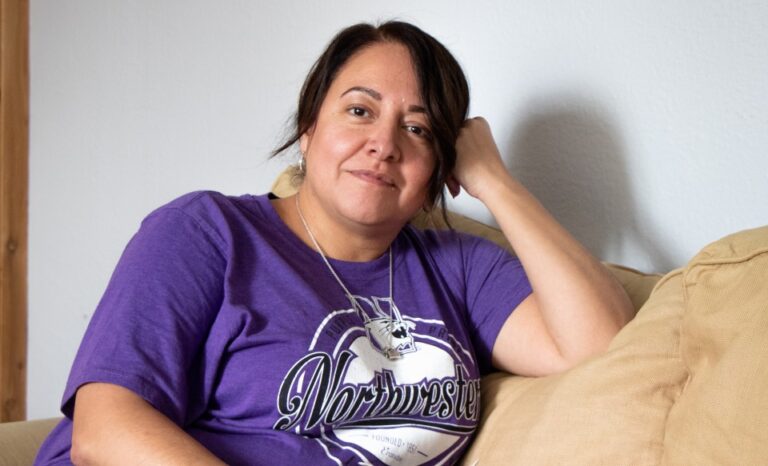At around noon on a recent Monday, Maria Garza logged on to Zoom.
She set her laptop on her kitchen stove and placed several plastic cups on the counter. One by one, she filled them up with things like baking soda and ammonia ahead of a chemistry experiment. Then, a classroom popped up on her screen.
“Hello Maria!” her professor called. Several other women wearing gray sweatsuits chimed in.
Garza, 48, mixed the liquids together to test their acidity but didn’t have much luck.
“All my stuff is brown!” she exclaimed. “Did anyone get a purple?”
“We got the colors, Maria!” someone shouted back. Her professor held up murky green and bright purple mixtures for her to see.
Garza and her classmates are all enrolled in Northwestern University’s Prison Education Program (NPEP), a liberal arts program for incarcerated women to get their bachelor’s degrees. Out of all her classmates, she is the only one zooming in from the outside.
The number of incarcerated people in degree programs is low. But as the Illinois Department of Corrections (IDOC) seeks to increase opportunities for higher education behind bars, it is having to figure out how to allow students like Garza to complete their education even when they’re released from prison in the middle of a semester or degree program.
According to IDOC, most of the higher education programs in prisons are so new they have yet to develop “re-entry plans” for people who are released. That leaves the few students who are released before the end of their programs worried about how they’re going to stay in school once they’re out.
‘First student who came home’
Garza used to sit in the same classroom as her peers at the Logan Correctional Center, 180 miles southwest of Chicago, until she was released a little over a year ago. Now, out of a dozen or so students, she’s the only one calling in from the outside.
“Maria was our first student who came home and we didn’t even know at the time that the IDOC would allow students to continue by zooming in,” said NPEP program director Jennifer Lackey, whose office on the Northwestern campus in Evanston is filled with photos of her students who are incarcerated.
Northwestern began its degree program at the women’s prison in Logan in 2020 but they didn’t have a plan for students like Garza who would be released in the middle of their studies, Lackey said.
People on the outside need clearance to communicate with people in prison, so the IDOC agreed to approve Garza as long as she spoke to her peers only about school-related things during class.
“So in other words, I can’t be on Zoom and say, ‘Hey, I talked to your daughter.’ It all has to be about the class and the homework and the assignments,” Garza said.
But even zooming requires having cameras and TVs set up in prison classrooms, which wasn’t standard practice before the pandemic.
As schools and prisons went on lockdown to mitigate the spread of the virus, NPEP received a $100,000 grant from the Andrew W. Mellon Foundation to address COVID-19 challenges. Lackey said they used the money to install video conferencing equipment in prison classrooms.
“Once that became a possibility, the kind of parameters of re-entry support shifted at that moment,” Lackey said.
Now, NPEP students leaving prison have three options. They can take in-person classes on the Evanston campus, enroll in an online program or stick with their prison cohort and zoom into classes on the inside.
Though being in person would be ideal, Lackey said it can be challenging for people with records to find housing and a job near campus. She also acknowledges there is a lot of resistance to offering this kind of re-entry support.
“For many universities, there is not only stigma around prison education programs, but I would say additional stigma around having formerly incarcerated students on campus.”
Changing the narrative
Aside from Northwestern, North Park University is one of the few prison programs that also offers its students a re-entry path. They run a master’s program in Christian ministry at Logan and the Stateville Correctional Center, a prison about 40 miles from Chicago.
“So far, we’ve had four students be released,” said program director Vickie Reddy. “And every single one of them has come out and has lived on or around campus.”
The program helps its students find housing and connects them to job opportunities on campus. They have also had graduates go on to teach within the program.
By creating this path, they’re trying to change how society views people leaving prison. Still, Reddy cedes that having formerly incarcerated people on campus is an experiment that educators are still figuring out how to navigate. And the stigma around crime and incarceration weighs heavily on the students who have just left prison.
“All it takes is for one person to come out and screw up in some way, and it will mess everything up,” Reddy said. “Because we look at the one, not at everyone else who’s doing amazing.
Back in her kitchen with her liquids that have turned all the wrong colors, Garza said she’s found strength in staying connected with her peers by logging into prison twice a week.
“To me, it’s kind of like a comfort,” Garza said. “There are people who would say that once they leave [prison] they detach themselves from everything. But it’s hard to detach yourself from the people that understand what you’re going through.”
She thinks it’s helping her incarcerated classmates too — helping them stay connected to the world and seeing one of their peers finishing their degree on the outside.
Anna Savchenko covers criminal justice for WBEZ. Follow @annasavchenkoo

